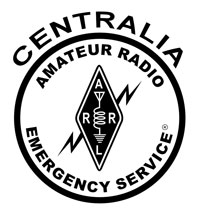
2019 certainly ended in a way none of our team expected. On New Year’s Eve, Lyle Olmsted, KB7PI, passed away at Centralia Providence Hospital. In 2008, the Centralia Police Department and Riverside Fire Authority were searching for ways to overcome the sudden and destructive forces experienced during the December 2007 area wide flood that closed Interstate 5 for three days, when we created the Centralia Amateur Radio Emergency Service team. Its purpose at the time was to provide the Centralia EOC with backup communications should all normal comms fail during a similar disaster.
The police department created a form letter and sent it out to every one of the 450 amateur radio operators in Lewis County asking if they would consider helping with the formation of an ARES team. Lyle Olmsted was the very first volunteer, marching into my office only hours after he received the letter in the mail. I had no idea how important this man would become to our fledgling ARES team or to me personally over the next ten years. Lyle arrived so quickly I had only just started to create a volunteer application form for the team. Holding an Advanced amateur radio license and a desire to make it all work, Lyle became our first Assistant Emergency Coordinator, a post he held until a year before his passing when he stepped down to become our team advisor.
Our team’s two ARES Communications vans are a tribute to Lyle’s tenacity. Seeing a smaller box van owned by the police department that didn’t seem to have a real purpose, he proposed we create a mobile communications van. I’m sure when Chief Bob Berg handed me the keys and told us to have at it, he had pretty low expectations. Over coffee, I handed Lyle the keys and said “let’s do this”. The smile on his face was fun to see. Over the next year, Lyle designed the interior, sought out donations and used equipment and spent hours and hours working on every detail. When it was done, all Chief Berg could say was “Wow”. He was so impressed, when we asked for a second identical van so we could create a second communications van, he simply handed over the keys.
4,157 days. Lyle served the City of Centralia and Riverside Fire Authority as a Amateur Radio Emergency Service volunteer 4,157 days. If you’re lucky, friendships can last a lifetime. Sometimes less. The best friend I ever had walked into my office 4,157 days ago and simply said “I’m an Amateur Radio operator and I want to help.”

 It was 56 degrees, 11 mph winds and raining hard but two weeks after our ARES team designed a 6.0 earthquake it was time to put this disaster into play. Since we do these types of exercises fairly often, we tend to use one of our two hour training nights rather than a full day scenario. Not much time to get everything done, but it just makes us work faster. 10 minutes into the evening everyone had their scenario, action plan, safety briefing, tactical call signs, radio frequencies and assignments so out the door we went.
It was 56 degrees, 11 mph winds and raining hard but two weeks after our ARES team designed a 6.0 earthquake it was time to put this disaster into play. Since we do these types of exercises fairly often, we tend to use one of our two hour training nights rather than a full day scenario. Not much time to get everything done, but it just makes us work faster. 10 minutes into the evening everyone had their scenario, action plan, safety briefing, tactical call signs, radio frequencies and assignments so out the door we went. As October arrives, our ARES team once again ramps up for the “Mother Nature Picks On The Pacific Northwest” season. Training is switching from the wildfire preparations of summer to our fall flood response activities. It has been awhile since we’ve worked a good disaster exercise, so we decided to create one. During our October 7th training night, the team chose to design a 6.0 earthquake from a series of nine disaster scenarios that included floods, wildfires, wind storms and even a hurricane. The plan is to design a disaster selected by group consensus and then put that plan to the test during a field exercise on our October 21st training. We’ll debrief the exercise at our first November meeting and then create a better disaster.
As October arrives, our ARES team once again ramps up for the “Mother Nature Picks On The Pacific Northwest” season. Training is switching from the wildfire preparations of summer to our fall flood response activities. It has been awhile since we’ve worked a good disaster exercise, so we decided to create one. During our October 7th training night, the team chose to design a 6.0 earthquake from a series of nine disaster scenarios that included floods, wildfires, wind storms and even a hurricane. The plan is to design a disaster selected by group consensus and then put that plan to the test during a field exercise on our October 21st training. We’ll debrief the exercise at our first November meeting and then create a better disaster.